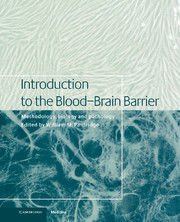Book contents
- Frontmatter
- Contents
- List of contributors
- 1 Blood–brain barrier methodology and biology
- Part I Methodology
- Part II Transport biology
- 18 Biology of the blood–brain glucose transporter
- 19 Glucose transporters in mammalian brain development
- 20 Blood–brain barrier amino acid transport
- 21 P-glycoprotein, a guardian of the brain
- 22 Blood–brain barrier ion transport
- 23 Ion channels in endothelial cells
- 24 Interactions of lipoproteins with the blood–brain barrier
- 25 Fatty acid and lipid intermediate transport
- 26 Blood–brain barrier transport of drugs
- Part III General aspects of CNS transport
- Part IV Signal transduction/biochemical aspects
- Part V Pathophysiology in disease states
- Index
21 - P-glycoprotein, a guardian of the brain
from Part II - Transport biology
Published online by Cambridge University Press: 10 December 2009
- Frontmatter
- Contents
- List of contributors
- 1 Blood–brain barrier methodology and biology
- Part I Methodology
- Part II Transport biology
- 18 Biology of the blood–brain glucose transporter
- 19 Glucose transporters in mammalian brain development
- 20 Blood–brain barrier amino acid transport
- 21 P-glycoprotein, a guardian of the brain
- 22 Blood–brain barrier ion transport
- 23 Ion channels in endothelial cells
- 24 Interactions of lipoproteins with the blood–brain barrier
- 25 Fatty acid and lipid intermediate transport
- 26 Blood–brain barrier transport of drugs
- Part III General aspects of CNS transport
- Part IV Signal transduction/biochemical aspects
- Part V Pathophysiology in disease states
- Index
Summary
Introduction
A drug-transporting P-glycoprotein (P-gp) is present in the blood–brain barrier of all mammals investigated, including humans. The P-gp is present in the apical membrane of the endothelial cells lining brain capillaries and optimally placed to extrude drugs from the endothelial cells into the blood. The generation of knockout mice, completely lacking P-gp in their brain capillaries, has provided a model system to test the ability of P-gp to guard the brain against intrusion of compounds that are lipophilic enough to diffuse readily across the blood–brain barrier. Drugs transported by P-gp accumulate to a much higher extent in the brains of the knockout mice than in those of wild-type mice. For drugs such as vinblastine, ivermectin or digoxin, the difference is one to two orders of magnitude. This shows that P-gp is an important component of the blood–brain barrier and that active extrusion of drugs by P-gp explains many, if not all, examples of lipophilic drugs entering the brain at a much lower rate than expected on the basis of their lipophilicity.
The presence of P-gp in the blood-brain barrier has potential consequences for drug use and drug design. Following the development of potent inhibitors of P-gp (so-called reversal agents) with relatively low toxicity, clinical trials have been started in which these inhibitors are used to overcome multidrug resistance in tumors.
- Type
- Chapter
- Information
- Introduction to the Blood-Brain BarrierMethodology, Biology and Pathology, pp. 198 - 206Publisher: Cambridge University PressPrint publication year: 1998
- 5
- Cited by



